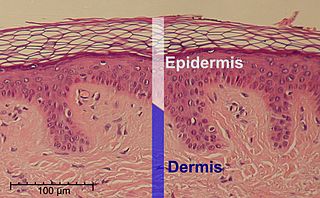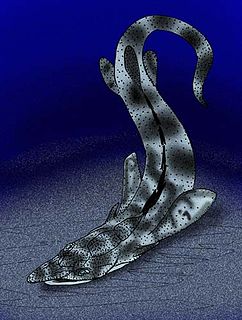Related Research Articles

The integumentary system is the set of organs forming the outermost layer of an animal's body. It comprises the skin and its appendages, acting as a physical barrier between the external environment and the internal environment that it serves to protect and maintain.

The epidermis is the outermost of the three layers that make up the skin, the inner layers being the dermis and hypodermis. The epidermis layer provides a barrier to infection from environmental pathogens and regulates the amount of water released from the body into the atmosphere through transepidermal water loss.

The stratum lucidum is a thin, clear layer of dead skin cells in the epidermis named for its translucent appearance under a microscope. It is readily visible by light microscopy only in areas of thick skin, which are found on the palms of the hands and the soles of the feet.

The stratum granulosum is a thin layer of cells in the epidermis lying above the stratum spinosum and below the stratum corneum. Keratinocytes migrating from the underlying stratum spinosum become known as granular cells in this layer. These cells contain keratohyalin granules, which are filled with histidine- and cysteine-rich proteins that appear to bind the keratin filaments together. Therefore, the main function of keratohyalin granules is to bind intermediate keratin filaments together.

Plagiosternum was a middle Triassic temnospondyl that is native to Spitzbergen.

Pseudopetalichthyida is an extinct order of lightly armored placoderms known only from rare fossils in Lower Devonian strata in Hunsrück, Germany. Like Stensioella heintzi, and the Rhenanida, the Pseudopetalichthids had armor made up of a mosaic of tubercles. Like Stensioella heintzi, the Pseudopetalichthids' placement within Placodermi is suspect. However, due to a gross lack of whole, uncrushed, articulated specimens, there are no other groups that the Pseudopetalichthids could be, for a lack of a better word, pigeonholed into.
Hypergranulosis is an increased thickness of the stratum granulosum. It is seen in skin diseases with epidermal hyperplasia and orthokeratotic hyperkeratosis.
The granular salamander or ajolote is a species of mole salamander in the family Ambystomatidae. It is found only in Mexico. Its natural habitats are subtropical or tropical high-altitude grassland, freshwater marshes, intermittent freshwater marshes, and ponds. It is threatened by habitat loss and overcropping along with the scaling of their skins.
Corynebacterium granulosum is a bacterium that may stimulate the immune system to fight cancer.
Dyskeratosis is abnormal keratinization occurring prematurely within individual cells or groups of cells below the stratum granulosum.
Exfoliatin is a Staphylococcus aureus exotoxin that causes a blistering of the skin known as staphylococcal scalded skin syndrome, usually in infants.

Nessariostoma granulosum is a lightly armored pseudopetalichthyid placoderm from the Hunsrückschiefer Lagerstätte of Early Devonian Germany. The type and only known specimen is an articulated, but very incomplete individual, deformed and elongated, consisting of a large, incomplete, tubercle-covered head, a long, beak-like rostrum, and some of the trunk, with a total length of 18 centimeters. N. granulosum was once placed in Stensioellida, though most other experts regard it at as a pseudopetalichthyid: Denison 1978 regards it as a placoderm incertae sedis because the specimen is deformed and so poorly preserved so as to stymie proper attempts at classification.
Morimopsini is a tribe of longhorn beetles of the subfamily Lamiinae. It was described by Lacordaire in 1869.
Protilema is a genus of longhorn beetles of the subfamily Lamiinae, containing the following species:
Protilema gigas is a species of beetle in the family Cerambycidae. It was described by Per Olof Christopher Aurivillius in 1908 and is known from Papua New Guinea.
Protilema humeridens is a species of beetle in the family Cerambycidae. It was described by Per Olof Christopher Aurivillius in 1926.
Protilema montanum is a species of beetle in the family Cerambycidae. It was described by Kriesche in 1923.
Protilema papus is a species of beetle in the family Cerambycidae. It was described by Vitali and Menufandu in 2010. It is known from Indonesia.
Protilema rotundipenne is a species of beetle in the family Cerambycidae. It was described by Stephan von Breuning in 1947.
Protilema strandi is a species of beetle in the family Cerambycidae. It was described by Stephan von Breuning in 1940.
References
- ↑ BioLib.cz - Protilema granulosum. Retrieved on 8 September 2014.